Propagation Characteristics of Multi-Cluster Hydraulic Fracturing in Shale Reservoirs with Natural Fractures
Abstract
1. Introduction
2. Study on the Compressive and Tensile Mechanical Properties of Shale
2.1. Uniaxial Compression and Brazilian Splitting Tests
2.2. Study on the Compressive Strength of Shale
2.3. Study on the Tensile Properties of Shale
3. Numerical Model for Multi-Cluster Hydraulic Fracturing in Shale Reservoirs with Natural Fractures
3.1. Modeling Methods for Hydraulic Fracturing
3.2. Multi-Cluster Hydraulic Fracturing in Shale Reservoirs with Natural Fractures
4. Results and Analysis
4.1. Hydraulic Fracture Propagation in Case 1
4.2. Influence of Ground Stress on Fracture Propagation
4.2.1. Effect of Vertical Ground Stress
4.2.2. Effect of the Difference in the Horizontal Ground Stress
4.3. Effect of Injection Conditions on Fracture Propagation
4.3.1. Effect of Injection Rate
4.3.2. Effect of Fracturing Fluid Viscosity
5. Conclusions
- (1)
- The shale samples exhibit distinct bedding planes, showing significant anisotropy. The elastic compressive modulus and Poisson’s ratio of the parallel bedding shale samples are similar to those of the vertical bedding shale samples, while the compressive strength of the parallel bedding shale samples is significantly greater than that of the vertical bedding shale samples. The elastic compressive modulus of the parallel bedding shale samples ranges from 22.42 to 32.74 GPa with a Poisson’s ratio between 0.11 and 0.15 and a compressive strength ranging from 127.82 to 223.21 MPa. The elastic compressive modulus of the vertical bedding shale samples ranges from 25.56 to 31.90 GPa with a Poisson’s ratio between 0.13 and 0.18 and a compressive strength ranging from 83.53 to 158.22 MPa.
- (2)
- The anisotropy in the tensile performance of shale by Brazilian splitting test is significant. Both vertical and horizontal bedding shale curves from the tests show increasing load with more vertical displacement, then a sharp drop in load. The ultimate failure load and tensile strength of the parallel bedding shale samples are less than those of the vertical bedding shale samples. The ultimate failure load of the parallel bedding shale samples ranges from 2.20 to 4.51 kN with a tensile strength of 3.68 to 7.54 MPa. The ultimate failure load of the vertical bedding shale samples ranges from 7.91 to 8.98 kN with a tensile strength of 13.01 to 14.65 MPa.
- (3)
- The tensile modulus of the parallel bedding shale samples is greater than that of the vertical bedding shale samples. The tensile modulus of the parallel bedding shale samples ranges from 4.52 to 5.19 GPa, while the tensile modulus of the vertical bedding shale samples ranges from 3.52 to 3.75 GPa. The elastic compressive modulus of the shale is 6 to 10 times the tensile modulus.
- (4)
- Under two different levels of the vertical ground stress (Cases 1 and 2), when the vertical ground stress of the reservoir was low, the hydraulic fracture induced by the injection well closest to the natural fracture expanded the fastest, and the natural fracture opened when it intersected with the hydraulic fracture. Through studies on two different levels of the horizontal ground stress (Cases 1 and 3), it was evident that when there was a greater difference in the horizontal ground stress, the natural fractures were more inclined to open after the point at which the hydraulic and natural fractures intersected.
- (5)
- The results from Case 4 revealed that as the injection rate increased, there was a corresponding increase in the initial pressure, the speed at which the hydraulic fracture area increased, and the speed of fracture spreading. Compared with the simulation results from Cases 4 and 5, it was evident that a higher viscosity of the fracturing fluid led to a faster propagation of the hydraulic fractures.
- (6)
- The experimental and numerical research findings could improve the fracturing process through a better understanding of the fracture propagation process and offer a scientific foundation for the efficient development of shale gas reservoirs and to foster advancements in hydraulic fracturing technology.
Author Contributions
Funding
Institutional Review Board Statement
Informed Consent Statement
Data Availability Statement
Conflicts of Interest
References
- Fateh, B.; Aisha, A.; Raed, A. Balancing climate mitigation and energy security goals amid converging global energy crises: The role of green investments. Renew. Energy 2023, 205, 534–542. [Google Scholar] [CrossRef]
- Li, S.; Hu, Z.; Chang, X. Mechanistic study on the influence of stratigraphy on the initiation and expansion pattern of hydraulic fractures in shale reservoirs. Appl. Sci. 2022, 16, 8082. [Google Scholar] [CrossRef]
- Weber, N.; Fries, T. The XFEM with an Implicit-Explicit Crack Description for a Plane-Strain Hydraulic Fracture Problem. PAMM 2013, 1, 83–84. [Google Scholar] [CrossRef]
- Wang, X.; Shi, F.; Liu, H.; Wu, H. Numerical simulation of hydraulic fracturing in orthotropic formation based on the extended finite element method. J. Nat. Gas Sci. Eng. 2016, 33, 56–69. [Google Scholar] [CrossRef]
- Fatahi, H.; Hossain, M.M.; Sarmadivaleh, M. Numerical and experimental investigation of the interaction of natural and propagated hydraulic fracture. J. Nat. Gas Sci. Eng. 2017, 37, 409–424. [Google Scholar] [CrossRef]
- Olga, K.; Weng, X. Numerical Modeling of 3D Hydraulic Fractures Interaction in Complex Naturally Fractured Formations. Rock Mech. Rock Eng. 2018, 51, 3863–3881. [Google Scholar] [CrossRef]
- Xie, L.; Min, K.B.; Shen, B. Simulation of hydraulic fracturing and its interactions with a pre-existing fracture using displacement discontinuity method. J. Nat. Gas Sci. Eng. 2016, 36, 1284–1294. [Google Scholar] [CrossRef]
- Shakib, T.J.; Shahri, A.G.A. Analysis of hydraulic fracturing in fractured reservoir: Interaction between hydraulic fracture and natural fractures. Life Sci. J. 2012, 9, 1862. [Google Scholar] [CrossRef]
- Chen, M.; Li, M.; Wu, Y.; Bang, K. Simulation of hydraulic fracturing using different mesh types based on zero thickness cohesive element. Processes 2020, 82, 189. [Google Scholar] [CrossRef]
- Hunsweck, M.; Shen, Y.; Lew, A. A finite element approach to the simulation of hydraulic fractures with lag. Int. J. Numer. Anal. Methods Geomech. 2013, 79, 993–1015. [Google Scholar] [CrossRef]
- Zhou, J.; Zhang, L.; Braun, A.; Han, Z. Numerical Modeling and Investigation of Fluid-Driven Fracture Propagation in Reservoirs Based on a Modified Fluid-Mechanically Coupled Model in Two-Dimensional Particle Flow Code. Energies 2016, 9, 699. [Google Scholar] [CrossRef]
- Carrier, B.; Granet, S. Numerical modeling of hydraulic fracture problem in permeable medium using cohesive zone model. Eng. Fract. Mech. 2012, 79, 312–328. [Google Scholar] [CrossRef]
- Wang, D.; Dong, Y.; Sun, D.; Yu, B. A three-dimensional numerical study of hydraulic fracturing with degradable diverting materials via CZM-based FEM. Eng. Fract. Mech. 2020, 237, 107251. [Google Scholar] [CrossRef]
- Ping, E.; Zhao, P.; Zhu, H.; Zi, J.; Qing, Z.; Gan, F. Numerical Simulation of the Simultaneous Development of Multiple Fractures in Horizontal Wells Based on the Extended Finite Element Method. Energies 2024, 17, 1057. [Google Scholar] [CrossRef]
- Wen, J.; Xiang, T.; Zhu, M.; Hu, P.; Mao, J.; Jing, Y.H. Investigation of shale hydraulic fracturing propagation laws based on extended finite element analysis. Drill. Eng. 2022, 5, 177–188. [Google Scholar]
- Cherny, S.; Lapin, V.; Esipov, D.; Avdyushenko, A.; Lyutov, A.; Karnakov, P. Simulating fully 3D non-planar evolution of hydraulic fractures. Int. J. Fract. 2016, 2, 209–211. [Google Scholar] [CrossRef]
- Zhang, F.; Wang, X.; Tang, M.; Du, X.F.; Xu, C.C.; Tang, J.Z.; Damjanac, B. Numerical investigation on hydraulic fracturing of extremely limited entry perforating in plug-and-perforation completion of shale oil reservoir in Changqing oilfield, China. Rock Mech. Rock Eng. 2021, 54, 2925–2941. [Google Scholar] [CrossRef]
- Kang, X.; Jiang, M.; Huan, G.; Wu, J.N.; Tang, M.; Wang, Z.Y. Application research on fracture propagation law of combined hydraulic pressure in multiple coal fractures. J. Min. Saf. Eng. 2021, 3, 602–608. [Google Scholar]
- Wang, Y.; Liu, N.; Wang, H. Simulation investigation on spatial deflection of multiples fractures of multistage perforation clusters in hydraulic fracturing. Coal Sci. Technol. 2023, 5, 160–169. [Google Scholar]
- Li, M.; Zhou, D.; Su, Y. Simulation of fully coupled hydro-mechanical behavior based on an analogy between hydraulic fracturing and heat conduction. Comput. Geotech. 2023, 156, 105259. [Google Scholar] [CrossRef]
- Wang, Y.; Ju, Y.; Zhang, H.; Song, J.X.; Li, Y.; Chen, J. Adaptive finite element-discrete element analysis for the stress shadow effects and fracture interaction behaviors in three-dimensional multistage hydrofracturing considering varying perforation cluster spaces and fracturing scenarios of horizontal wells. Rock Mech. Rock Eng. 2021, 54, 1815–1839. [Google Scholar] [CrossRef]
- Hou, Z.; Yang, C.; Guo, Y.; Zhang, B.; Wei, Y.; Heng, S.; Wang, L. Study on the anisotropic characteristics of Longmaxi Formation shale under uniaxial compression. Rock Soil Mech. 2015, 36, 2541–2550. [Google Scholar]
- Li, Z. Study on the Anisotropic Characteristics of Rock under Uniaxial Compression. J. Railw. Sci. Eng. 2008, 3, 69–72. [Google Scholar]
- Jia, C.; Chen, J.; Guo, Y. Research on the Mechanical Properties and Failure Modes of Laminated Shale. Rock Soil Mech. 2013, 34 (Suppl. S2), 57–61. [Google Scholar]
- Istvan, J.A.; Evans, L.J.; Weber, J.H.; Devine, C. Rock mechanics for gas storage in bedded salt caverns. Int. J. Rock Mech. Min. Sci. 1997, 34, 142. [Google Scholar] [CrossRef]
- McLamore, R.; Gray, E. The mechanical behavior of anisotropic sedimentary rocks. J. Eng. Industry. 1967, 89, 62–73. [Google Scholar] [CrossRef]
- Debecker, B.; Vervoort, A. Experimental observation of fracture patterns in layered slate. Int. J. Fract. 2009, 159, 51–62. [Google Scholar] [CrossRef]
- Liu, Y.; Fu, H.; Rao, J.; Dong, H.; Cao, Q. Research on Brazilian disc splitting tests for anisotropy of slate under influence of different bedding orientations. Chin. J. Rock Mech. Eng. 2012, 31, 785–791. [Google Scholar]
- Zhong, S.; Zuo, S.; Luo, S. Brazilian tensile strength and tensile damage anisotropy of laminated limestone. Sci. Technol. Eng. 2020, 20, 6578–6584. [Google Scholar]
- Guo, W.; Guo, Y.; Yang, H.; Wang, L.; Liu, B.H.; Yang, C.H. Tensile mechanical properties and AE characteristics of shale in triaxial Brazilian splitting tests. J. Pet. Sci. Eng. 2022, 219, 111080. [Google Scholar] [CrossRef]
- Hou, P.; Gao, F.; Yang, Y.; Zhang, Z.Z.; Gao, Y.N.; Zhang, X.X.; Zhang, J. Effect of bedding plane direction on acoustic emission characteristics of shale in Brazilian tests. Rock Soil Mech. 2016, 37, 1603–1612. [Google Scholar]
- Wang, W.; Wu, K.; Olson, J. Characterization of hydraulic fracture geometry in shale rocks through physical modeling. Int. J. Fract. 2019, 216, 71–85. [Google Scholar] [CrossRef]
- Xiao, Y.; Zhanz, L.; Deng, H.; Deng, Y.; He, W.; Wang, D. Intersection and propagation laws of hydraulic fractures and natural fractures and true axial physical simulation experiment. Oil Drill. Prod. Technol. 2021, 1, 83–88. [Google Scholar]
- Guo, J.; Luo, B.; Lu, C.; Lai, J.; Ren, J.C. Numerical investigation of hydraulic in a layered reservoir using the cohesive zone method. Eng. Fract. Mech. 2017, 186, 195–207. [Google Scholar] [CrossRef]
- Shi, X.; Huang, H.; Zeng, B.; Guo, T.; Jiang, S. Perforation cluster spacing optimization with hydraulic fracturing-reservoir simulation modeling in shale gas reservoir. Geomech. Geophys. Geo-Energy Geo-Resour. 2022, 8, 141. [Google Scholar] [CrossRef]
- Li, H.; Lei, H.; Yang, Z.; Wu, J.Y.; Zhang, X.X.; Li, S.D. A hydro-mechanical-damage fully coupled cohesive phase field model for complicated fracking simulations in poroelastic media. Comput. Methods Appl. Mech. Eng. 2022, 399, 115451. [Google Scholar] [CrossRef]
- Zhang, R.; Chen, M.; Tang, H.; Xiao, H.-S.; Zhang, D.-L. Production performance simulation of a horizontal wells in a shale gas reservoir considering the propagation of hydraulic fractures. J. Pet. Sci. Eng. 2023, 21, 111272. [Google Scholar] [CrossRef]
- Sarris, E.; Papanastasiou, P. The influence of the cohesive process zone in hydraulic fracturing modelling. Int. J. Fract. 2011, 1, 33–45. [Google Scholar] [CrossRef]
- Zhang, J.; Yu, H.; Wang, Q.; Lv, C.S.; Liu, C.; Shi, F.; Wu, H.A. Hydraulic fracture propagation at weak interfaces between contrasting layers in shale using XFEM with energy-based criterion. J. Nat. Gas Sci. Eng. 2022, 101, 104502. [Google Scholar] [CrossRef]
- Mogilevskaya, S.; Rothenburg, L.; Dusseault, M. Growth of Pressure-Induced Fractures in the Vicinity of a Wellbore. Int. J. Fract. 2000, 104, 23–30. [Google Scholar] [CrossRef]
- Rueda, J.; Mejia, C.; Roehl, D. 3D unrestricted fluid-driven fracture propagation based on coupled hydromechanical interface elements. Eng. Fract. Mech. 2022, 272, 108680. [Google Scholar] [CrossRef]
- Wang, D.; Zhou, F.; Ding, W.; Ge, H.; Jia, X.F.; Shi, Y.; Wang, X.Q.; Yan, X.M. A numerical simulation study of fracture reorientation with a degradable fiber-diverting agent. J. Nat. Gas Sci. Eng. 2015, 25, 215–225. [Google Scholar] [CrossRef]
- Zou, J.; Jiao, Y.; Tan, F.; Lv, J.H.; Zhang, Q.Y. Complex hydraulic-fracture-network propagation in a naturally fractured reservoir. Comput. Geotech. 2021, 135, 104165. [Google Scholar] [CrossRef]
- Zhao, H.; Li, X.; Zhen, H.; Wang, X.H.; Li, S. Study on H-shaped fracture propagation and optimization in shallow dull-type coal fractures in the Hancheng block, China. J. Pet. Sci. Eng. 2023, 221, 111226. [Google Scholar] [CrossRef]
- Cordero, E.S.; Roehl, D.; Roehl, D. Numerical simulation of three-dimensional fracture interaction. Comput. Geotech. 2020, 122, 103528. [Google Scholar] [CrossRef]
- Huang, D.; Gu, D.; Yang, C.; Huang, R.Q.; Fu, G.Y. Investigation on mechanical behaviors of sandstone with two preexisting flaws under triaxial compression. Rock Mech. Rock Eng. 2016, 49, 375–399. [Google Scholar] [CrossRef]
- Xiao, T.; Li, X.; Jia, S. Failure characteristics of rock with two pre-existing transfixion cracks under triaxial compression. Chin. J. Rock Mech. Eng. 2015, 34, 2455–2462. [Google Scholar] [CrossRef]
- Huang, Y.; Yang, S.; Ju, Y.; Zhou, X.P.; Gao, F. Experimental study on mechanical behavior of rock-like materials containing pre-existing intermittent fissures under triaxial compression. Chin. J. Geotech. Eng. 2016, 38, 1212–1220. [Google Scholar]
- He, R.; Ren, L.; Zhang, R. Anisotropy characterization of the elasticity and energy flow of Longmaxi shale under uniaxial compression. Energy Rep. 2022, 8, 1410–1424. [Google Scholar] [CrossRef]
- Mengyang, Z.; Lei, X.; Fengchang, B.; Yang, B.C.; Huang, X.L.; Liang, N.; Ding, H. Effects of bedding planes on progressive failure of shales under uniaxial compression: Insights from acoustic emission characteristics. Theor. Appl. Fract. Mech. 2022, 119, 103343. [Google Scholar] [CrossRef]
- Shen, Z.; Zhou, L.; Li, X.; Zhang, S.Y.; Zhou, L. Hydraulic fracturing characteristics of laminated shale and its implications for fracture pressure. Coal Sci. Technol. 2023, 51, 119–128. [Google Scholar]
- Lekhnitskii, S.; Fern, P.; Brandstatter, J.; Dill, E.H. Theory of Elasticity of an Anisotropic Elastic Body. Phys. Today 2009, 17, 84. [Google Scholar] [CrossRef]
- Chen, C.; Pan, E.; Amadei, B. Determination of deformability and tensile strength of anisotropic rock using Brazilian tests. Int. J. Rock Mech. Min. Sci. 1998, 35, 43–61. [Google Scholar] [CrossRef]
- Wang, H.; Li, Y.; Cao, S.; Pan, R.K.; Yang, H.Y.; Zhang, K.W.; Liu, Y.B. Brazilian Splitting Test Study on Crack Propagation Process and Macroscopic Failure Pattern of Black Shale Containing Prefabricated Fractures. Chin. J. Rock Mech. Eng. 2020, 39, 912–926. [Google Scholar] [CrossRef]
- Wang, J.; Xie, H.-P.; Matthai, S.K.; Hu, J.-J.; Li, C.-B. The role of natural fracture activation in hydraulic fracturing for deep unconventional geo-energy reservoir stimulation. Pet. Sci. 2023, 4, 2141–2164. [Google Scholar] [CrossRef]
- Chen, Z. Finite element modelling of viscosity-dominated hydraulic fractures. J. Pet. Sci. Eng. 2012, 88, 136–144. [Google Scholar] [CrossRef]
- Yin, P.-F.; Yang, S.-Q.; Gao, F.; Tian, W.-L.; Zeng, W. Numerical investigation on hydraulic fracture propagation and multi-perforation fracturing for horizontal well in Longmaxi shale reservoir. Theor. Appl. Fract. Mech. 2023, 125, 103921. [Google Scholar] [CrossRef]



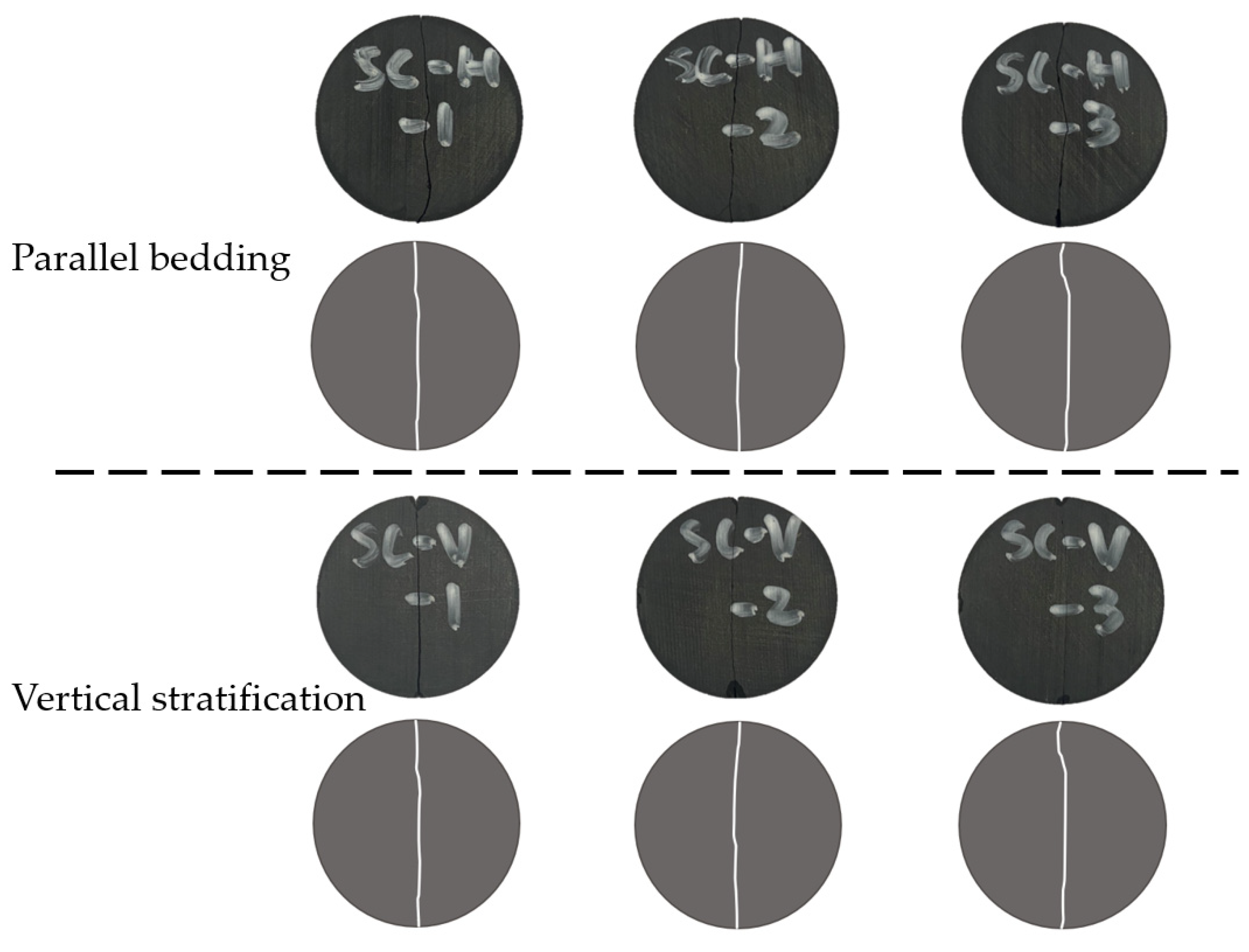

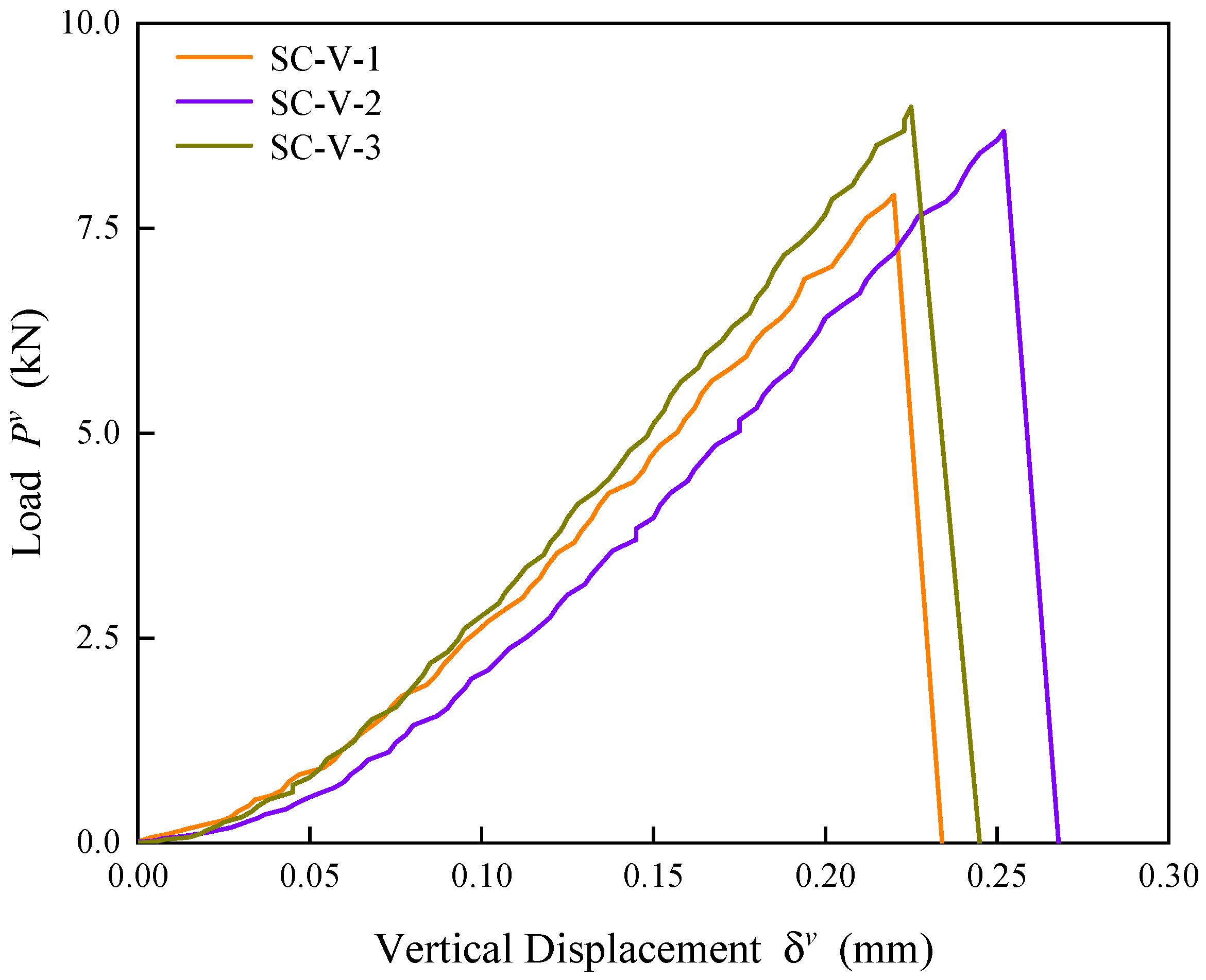
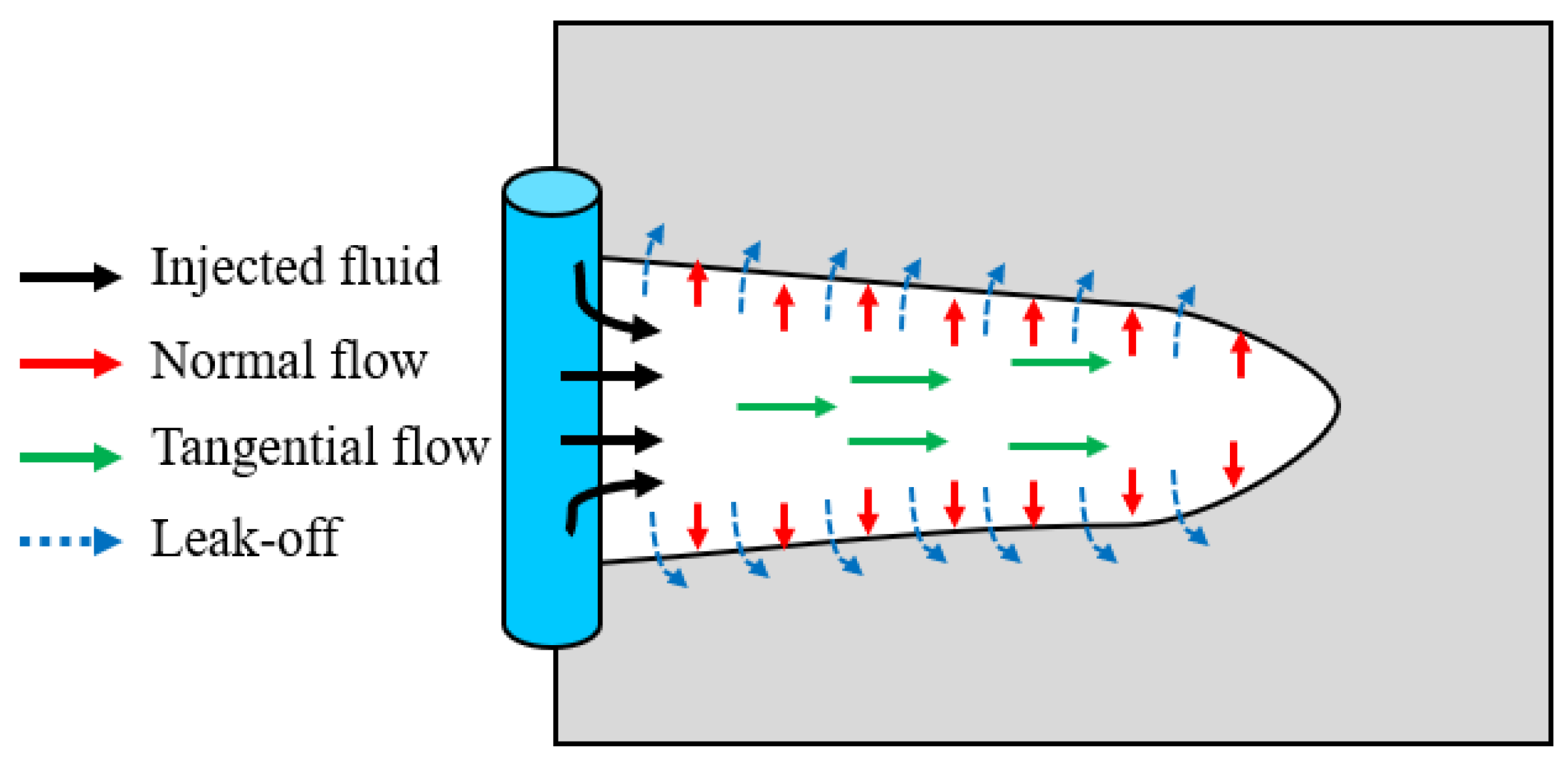



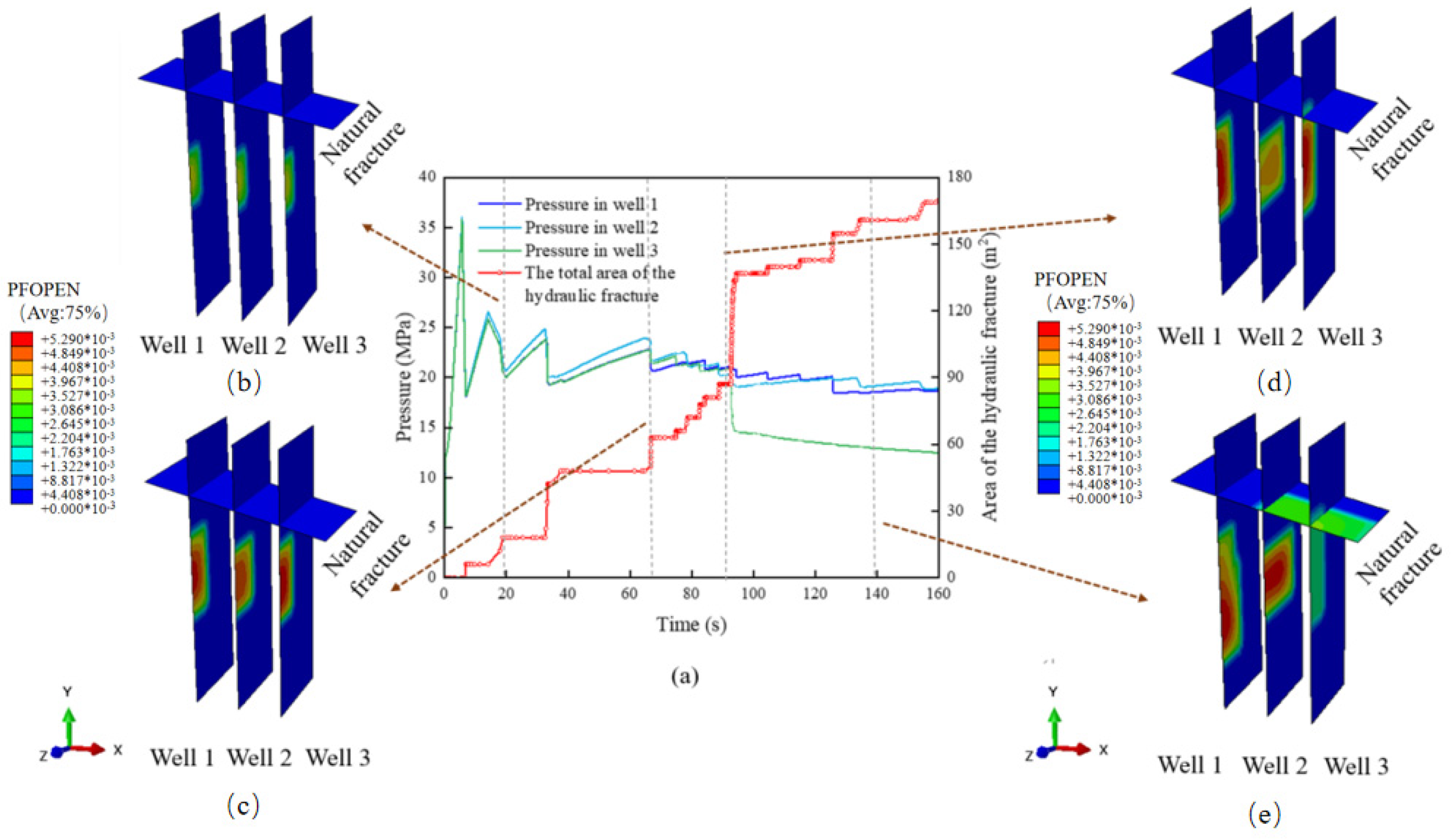

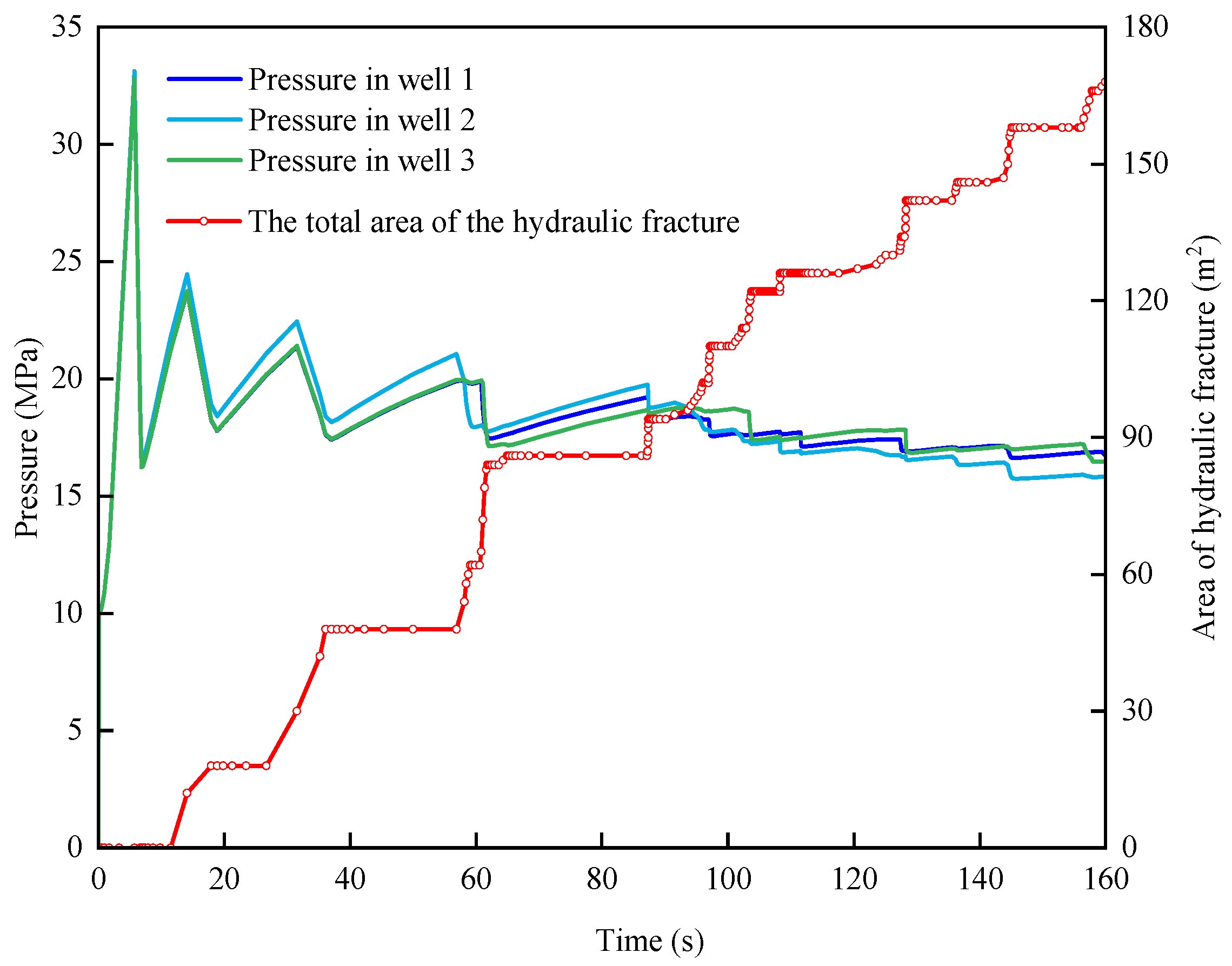


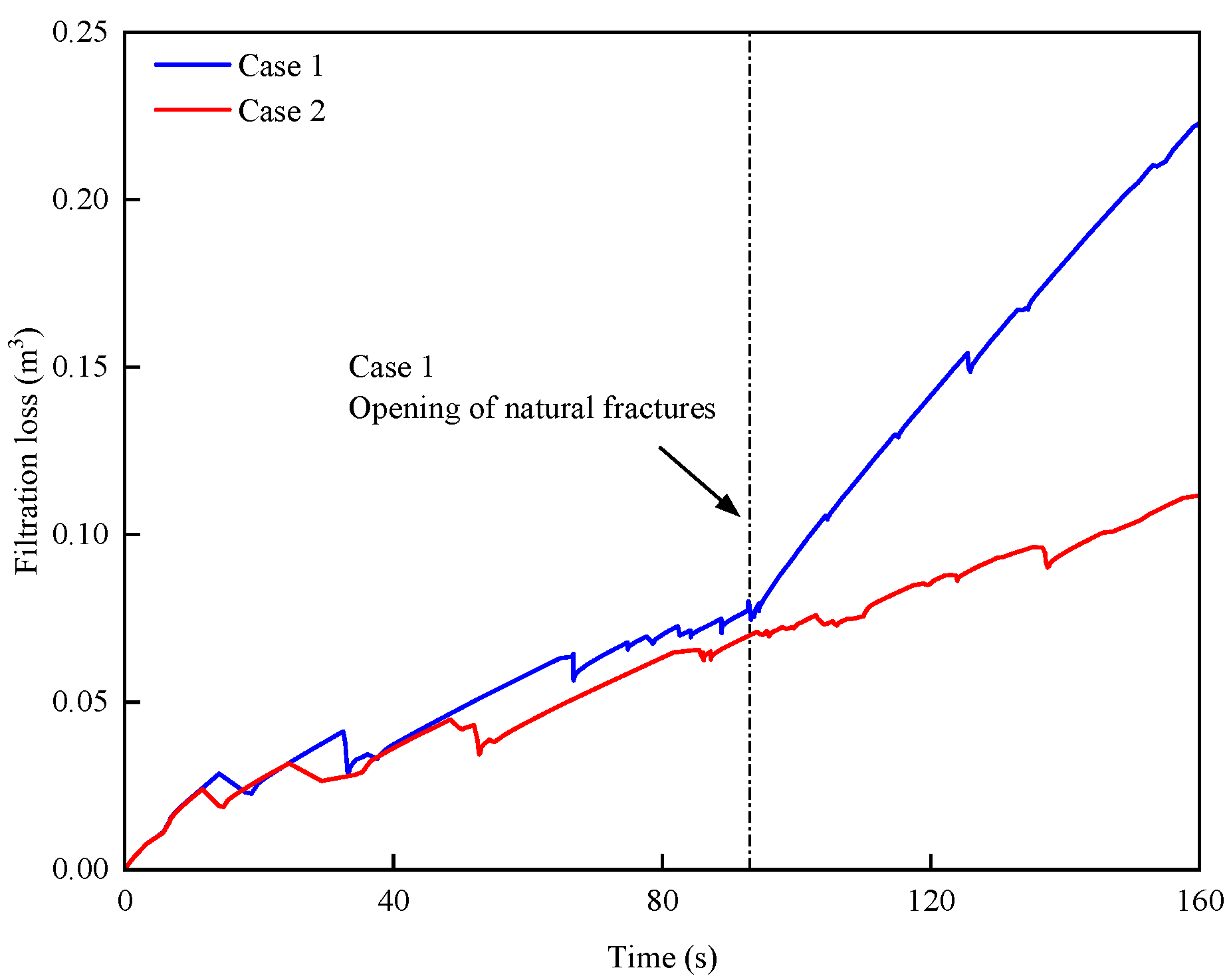
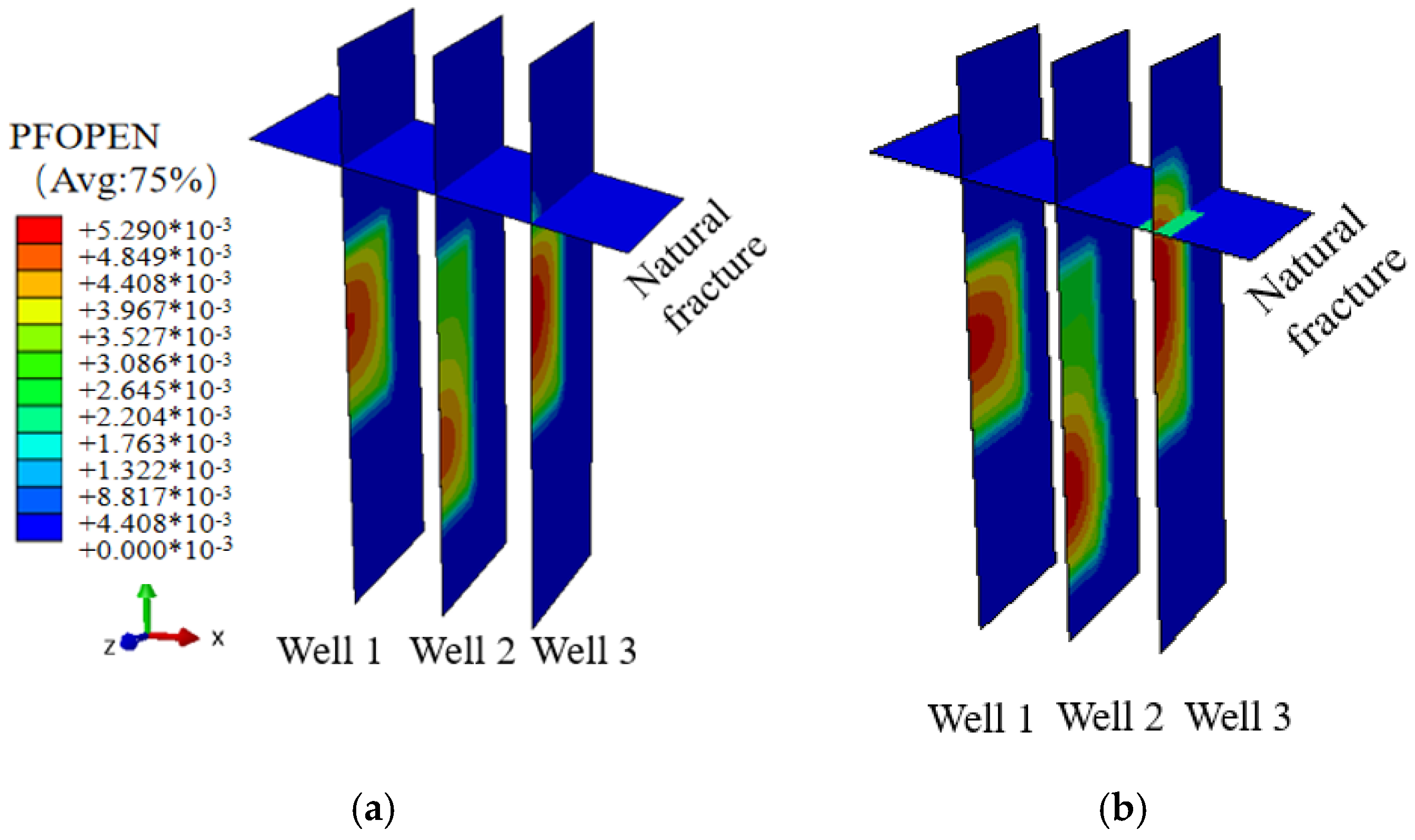

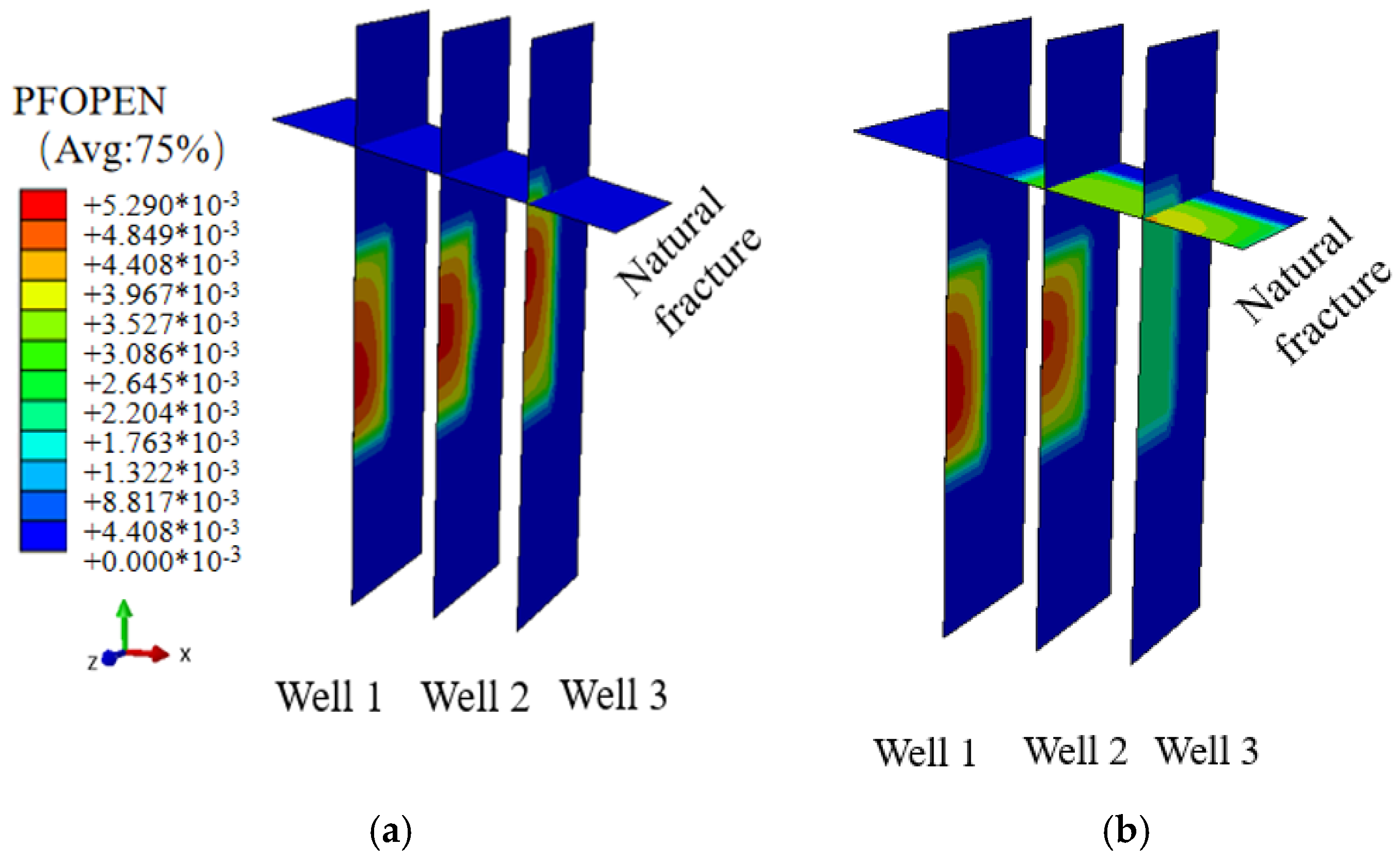


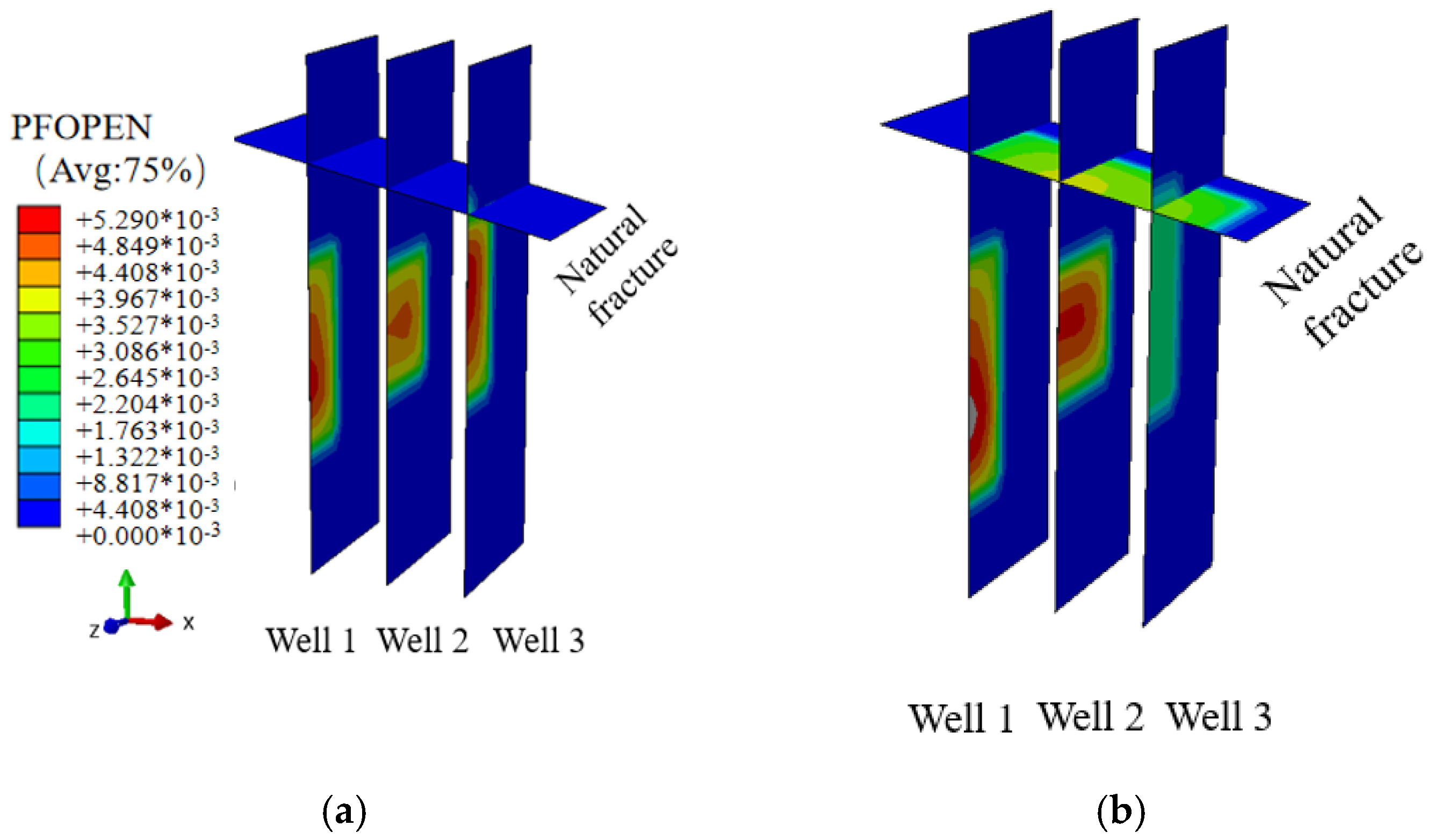


| Experiment Type | Bedding | Sample Number | Thickness H (mm) | Diameter D (mm) | Mass M (g) | Volume V (cm3) | Density ρ (g/cm3) |
|---|---|---|---|---|---|---|---|
| Uniaxial Compression | Parallel | sc-H-1 | 50.12 | 25.04 | 62.62 | 24.67 | 2.54 |
| sc-H-2 | 50.38 | 25.03 | 63.49 | 24.78 | 2.56 | ||
| sc-H-3 | 49.71 | 25.28 | 63.38 | 24.94 | 2.54 | ||
| Vertical | sc-V-1 | 49.42 | 25.22 | 63.84 | 24.68 | 2.59 | |
| sc-V-2 | 49.41 | 25.25 | 63.38 | 24.73 | 2.56 | ||
| sc-V-3 | 49.88 | 25.23 | 63.49 | 24.92 | 2.55 | ||
| Brazilian Splitting Test | Parallel | SC-H-1 | 15.37 | 24.88 | 18.52 | 7.47 | 2.48 |
| SC-H-2 | 15.29 | 24.96 | 18.43 | 7.48 | 2.46 | ||
| SC-H-3 | 15.33 | 24.87 | 18.48 | 7.44 | 2.48 | ||
| vertical | SC-V-1 | 15.26 | 25.20 | 20.01 | 7.61 | 2.63 | |
| SC-V-2 | 15.48 | 25.21 | 19.95 | 7.72 | 2.58 | ||
| SC-V-3 | 15.21 | 25.20 | 20.03 | 7.58 | 2.64 |
| Average Value | (GPa) | (MPa) | |
|---|---|---|---|
| sc-H-1 | 29.24 | 0.15 | 222.22 |
| sc-H-2 | 32.74 | 0.14 | 223.21 |
| sc-H-3 | 22.42 | 0.11 | 127.82 |
| Average Value | 28.13 | 0.13 | 191.08 |
| Average Value | (GPa) | (MPa) | |
|---|---|---|---|
| Variance | 31.90 | 0.15 | 127.25 |
| sc-V-2 | 25.56 | 0.18 | 158.22 |
| sc-V-3 | 28.25 | 0.13 | 83.53 |
| Average Value | 28.57 | 0.15 | 123.00 |
| Sample Number | (kN) | (MPa) | (GPa) |
|---|---|---|---|
| SC-H-1 | 4.15 | 6.91 | 4.71 |
| SC-H-2 | 4.51 | 7.54 | 5.19 |
| SC-H-3 | 2.20 | 3.68 | 4.52 |
| Average Value | 3.62 | 6.04 | 4.81 |
| Variance | 1.03 | 2.86 | 0.08 |
| Sample Number | (kN) | (MPa) | (GPa) |
|---|---|---|---|
| SC-V-1 | 7.91 | 13.01 | 3.52 |
| SC-V-2 | 8.66 | 14.29 | 3.64 |
| SC-V-3 | 8.98 | 14.65 | 3.75 |
| Average Value | 8.52 | 13.98 | 3.64 |
| Variance | 0.20 | 0.50 | 0.01 |
| Parameter | Parallel to the Bedding | Vertical to the Bedding | Parameter | Value |
|---|---|---|---|---|
| (GPa) | 28.13 | 28.57 | (MPa) | 32 |
| (GPa) | 4.81 | 3.64 | (MPa) | 30 |
| 0.13 | 0.15 | (MPa) | 28 | |
| (MPa) | 191.08 | 123 | (m/s1/2) | 1 × 10−14 |
| Shear stiffness (GPa/m) | 3000 | 3000 | (m/s1/2) | 1 × 10−13 |
| (MPa) | 6.04 | 13.98 | (MPa) | 2 |
| (Pa·m) | 5000 | 5000 | (Pa·m) | 1000 |
| (g/cm3) | 2.5 | 2.5 | (L/min) | 60 |
| Initial porosity e (%) | 3 | 3 | Fluid viscosity (mPa·s) | 1 |
| Case | (MPa) | (MPa) | (MPa) | (L/min) | (m·Pa) |
|---|---|---|---|---|---|
| Case 2 | 34 MPa | 30 MPa | 28 MPa | 60 L/min | 1 mPa·s |
| Case 3 | 32 MPa | — | 25 MPa | — | — |
| Case 4 | — | — | 28 MPa | 30 L/min | — |
| Case 5 | — | — | — | 30 L/min | 20 mPa·s |
Disclaimer/Publisher’s Note: The statements, opinions and data contained in all publications are solely those of the individual author(s) and contributor(s) and not of MDPI and/or the editor(s). MDPI and/or the editor(s) disclaim responsibility for any injury to people or property resulting from any ideas, methods, instructions or products referred to in the content. |
© 2025 by the authors. Licensee MDPI, Basel, Switzerland. This article is an open access article distributed under the terms and conditions of the Creative Commons Attribution (CC BY) license (https://creativecommons.org/licenses/by/4.0/).
Share and Cite
Yang, L.; Wang, X.; Niu, T. Propagation Characteristics of Multi-Cluster Hydraulic Fracturing in Shale Reservoirs with Natural Fractures. Appl. Sci. 2025, 15, 4418. https://doi.org/10.3390/app15084418
Yang L, Wang X, Niu T. Propagation Characteristics of Multi-Cluster Hydraulic Fracturing in Shale Reservoirs with Natural Fractures. Applied Sciences. 2025; 15(8):4418. https://doi.org/10.3390/app15084418
Chicago/Turabian StyleYang, Lianzhi, Xinyue Wang, and Tong Niu. 2025. "Propagation Characteristics of Multi-Cluster Hydraulic Fracturing in Shale Reservoirs with Natural Fractures" Applied Sciences 15, no. 8: 4418. https://doi.org/10.3390/app15084418
APA StyleYang, L., Wang, X., & Niu, T. (2025). Propagation Characteristics of Multi-Cluster Hydraulic Fracturing in Shale Reservoirs with Natural Fractures. Applied Sciences, 15(8), 4418. https://doi.org/10.3390/app15084418






